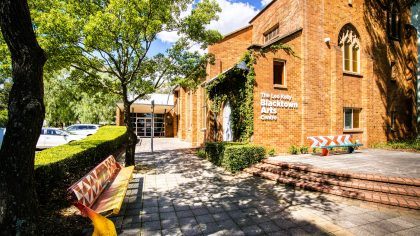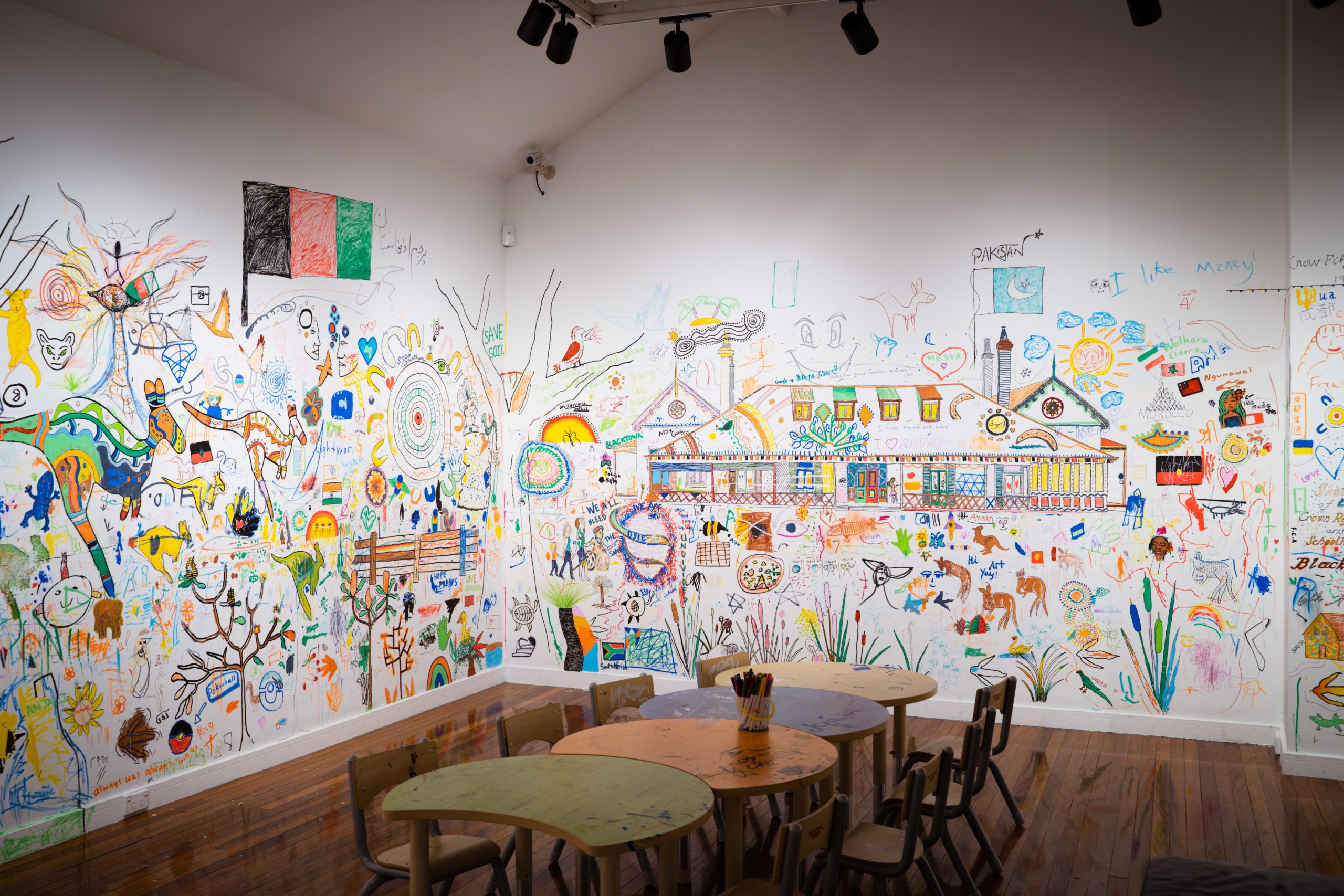
The Leo Kelly Blacktown Arts Centre
An innovative multi-arts hub in the heart of Blacktown City.
Bayadyinyang budyari Dharug yiyura Dharug Ngurra.
Bayady’u budyari Dharug Warunggadgu baranyiin barribugu.
Bayady’u budyari wagulgu yiyuragu Ngurra bimalgu Blacktown City. Flannel flowers dyurali bulbuwul.
Yanmannyang mudayi Dharug Ngurrawa. Walama ngyini budbud dali Dharug Ngurra Dharug yiyura baranyiin barribugu.
We acknowledge the Traditional Custodians of this Land, the Dharug people, and their continued connection to Country.
We pay our respects to Elders from yesterday to tomorrow.
We extend that respect to all Aboriginal and Torres Strait Islander Peoples of Blacktown City where the flannel flowers still grow proud and strong.
We will walk softly on this land and open our hearts to Country as the Dharug people have for tens of thousands of years.
Credit to: Dharug woman Rhiannon Wright, daughter of Leanne ‘Mulgo’ Watson Redpath and granddaughter of Aunty Edna Watson

‘Songlines & Sightlines,’ explains Dharug artist-educator Leanne Mulgo Watson, ‘is the story of Blacktown.’ The phrase names both the recent an exhibition at the Leo Kelly Blacktown Arts Centre and exploring the ways of relating to local place past, present, and future.
Contributions from Dharug knowledge-holders Leanne Mulgo Watson, Erin Wilkins, and the late Bundeluk Watson, alongside architect Peter Rush, were brought together by curator Tian Zhang for its second run in 2022 as part of Blacktown City Festival. Audience members became collaborators in the series of illustrations created by these artists within the Arts Centre, drawing directly onto the walls with paint textas.
The concept of the songline underpins the exhibition, and particularly the contributions by Dharug artists and community. Songlines for many First Nations’ cultural traditions, function as oral-narrative maps. They connect Country and people together, while working as a way to transmit information about particular local sites of significance, paths of travel, and histories of people’s relationships to land. Before colonisation, the paths described by songlines were often maintained and cared for by regular use, environmentally-conscious clearing, and controlled burning. They can often also trace the pathways which were travelled by ancestral beings as they moved through Country, singing it to life.
Leanne Mulgo Watson describes the stories traced by the Dharug songlines in her illustrations for ‘Songlines & Sightlines’: ‘In our Creation, it starts with the first sunrise, and then we have the birds, and the waterways and the mountains. The fence [that was drawn on the wall] represents the start of colonisation, and then it moves into the modern.’ Tian Zhang, too, emphasises that the project brings ‘different layers of Blacktown’ into conversation – or perhaps, more fittingly, into harmony – on the walls of the Arts Centre. Underpinning it all, are Dharug songlines shared by Leanne, Erin, and Bundeluk’s work, reminding us that this always was, and always will be Dharug land.
These ‘layers’ build through to the contemporary moment. Peter Rush, whose contributions included illustrations of local streets, businesses, and buildings, considers that his drawings depicted ‘the place we live in, the place we see every day – but we don’t necessarily think about its origins.’ Peter’s illustrations reappraised the notion of a ‘site of significance’, bringing an affectionate eye and enchanting hand to the everyday structure and substance of life in Blacktown. They reminded us that the sightline – the other concept for this program is not just as what is visible in the landscape or cityscape, but seeing in the first person. Here, mundane life, the shopping, the commute, the carrying out of business becomes interesting because it is ours, and its objects interesting because they are what we see. Recognisable sights, like families holding hands, local flora and fauna, and favourite spots like Ronnie’s Pizza, lent this first-person familiarity to ‘Songlines & Sightlines’.
So, too, did contributions by many locals – younger and older, and with a variety of relationships to this local place.
‘Songlines & Sightlines’ welcomed contributions from individuals and those who came to participate in community, school, or family groups. We particularly welcomed contributions from children and young people, many of whom wrote messages about their experiences of Blacktown – one note reading ‘RESPECT, HOPE, TRUST’ – or drew their familiar objects of encounter: houses, animals, families of all kinds, streetscapes, or power lines.
As Tian commented, ‘There are things that you can see, but there are also a lot of things that you don’t seem or which aren’t immediately visible, as well as different parts of history that are significant both to Dharug people and to other people who have come here.’ In this sense, ‘Songlines & Sightlines’ allowed our community to exchange stories, thoughts, and knowledge on an intricate and intimate level, speaking to and drawing about the small but significant details of life in this vibrant place.